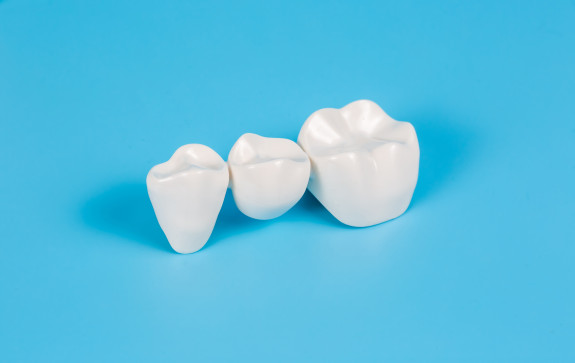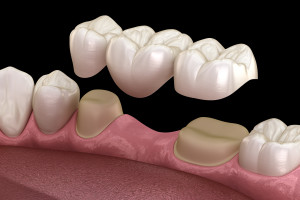Dental Bridges – Goodyear, AZ
Helping You Enjoy a Complete Smile Once More

Having multiple missing teeth can present you with all sorts of challenges, but particularly those surrounding eating and speaking. That’s not to say the issue won’t affect your confidence, though – meaning you should want a solution that isn’t just practical, but also confidence-inspiring. A dental bridge can fit this bill! Continue reading below to learn a little more about dental bridges and what they can do for your smile if you’re missing teeth; of course, don’t hesitate to contact us to learn more or schedule an appointment.
Why Choose Goodman Dental for Dental Bridges?
- Sedation Dentistry Solutions
- Flexible Financing Options Available
- Dental Implant-Retained Bridges
What is a Dental Bridge?

A dental bridge is a type of restoration that’s ideal for patients who are missing multiple teeth in a row along the same arch. A bridge includes a row of lifelike replacement teeth that are anchored in place using either dental crowns or strategically placed dental implants. These teeth don’t just look realistic, though; they can also restore oral functionality to a patient’s smile.
Types of Dental Bridges

When you come in, our team will inspect your smile and discuss your dental goals with you before determining which type of bridge suits your needs. We offer the following types of bridges here at our Goodyear office:
Traditional Dental Bridge

Traditional bridges rely on a row of replacement teeth, called pontics, situated between two dental crowns that are placed on the teeth adjacent to the gap. Keep in mind that longer bridges usually require more support, so the teeth adjacent to the gap must be healthy enough to support the bridge.
Implant Bridge

Implant bridges are slightly different than their traditional ones. Instead of relying on crowns placed on the healthy adjacent teeth, they’re supported with dental implants that are surgically placed beneath the gumline. Because of this, they’re able to provide far more support than traditional bridges, in addition to lasting much longer, since they replace the roots of the missing teeth.
The Benefits of Getting a Dental Bridge

When you receive a bridge, you aren’t just replacing your lost teeth; you’re vastly upgrading your quality of life! Here are some of the benefits that bridges have to offer:
- Whether you’re missing one, two, or a few teeth in a row, bridges are highly customizable and can easily fill gaps of all sizes.
- Bridges allow patients to bite, chew, and eat with ease, in addition to speaking and enunciating clearly.
- You don’t have to change up your oral hygiene regimen when you receive a dental bridge; brush and floss as usual, in addition to visiting us biannually.
Dental Bridges FAQs
Can You Take a Dental Bridge Out?
No, dental bridges are not designed to be taken out without professional assistance. If you attempt to remove it yourself, you could damage the restoration or your natural teeth. Bridges that feel loose or need replaced are considered dental emergencies, so give us a call right away if your bridge needs an adjustment! We’ll use our specialized tools and skills to take care of the issue for you.
Is Getting a Dental Bridge Painful?
Many patients find that dental bridge treatments in Goodyear are minimally uncomfortable. Our topical anesthetic is quite effective at numbing your mouth! However, if you do have a history of overly sensitive teeth or dental anxiety, please let us know. We offer oral conscious, nitrous oxide, and IV sedation, which are often able to help nervous patients feel more at ease.
Where you’re more likely to experience some discomfort is after your treatment. Your mouth will probably be sore. Fortunately, over the counter pain relievers are usually able to manage these types of aches. If your pain is severe or lasts longer than a week or two, call us right away so we can help.
How Long Should a Dental Bridge Last?
It depends on how well you take care of it. If you maintain a good oral hygiene routine and avoid habits like nail-biting, teeth grinding, and smoking, then your bridge could last for 10 years or more. Otherwise, it may only have a lifespan of five years or less.
Additionally, you might be interested to know that implant bridges tend to last even longer than traditional bridges. The extra support goes a long way towards promoting their longevity!
How Do I Clean Under My Dental Bridge?
For the most part, you can clean your bridge the same way you would for natural teeth: by brushing twice daily, flossing once per day, and visiting our office for checkups and cleanings every six months. That said, it is really important to clean underneath your bridge as well!
One way to do this is by using a threader to slide floss underneath your restoration. You’ll carefully move the floss back and forth to dislodge debris, and wrap it around the sides of your supporting teeth (or implants). If you don’t like the sound of that, interdental brushes are also an effective option. Finally, you could use a water flosser to remove debris with a steady stream of water. Whichever method works best for you will be the right way to clean underneath your bridge!
Are Dental Bridges Covered by Insurance?
Most dental insurance plans will cover 40% to 50% of the costs involved in a bridge treatment. However, every policy is different. You’ll have to read the details of your plan carefully to understand the terms of your benefits.
If you’re worried about affording treatment, ask our friendly team about CareCredit financing plans. Instead of paying your bill all at once, a CareCredit plan will allow you to pay in smaller monthly chunks at little-to-no-interest.
